
The Knickerbocker on the Lake is a historic hotel opened in 1929, located in the Yankee Hill neighborhood of downtown Milwaukee, Wisconsin. It was built as an eight-story residential apartment hotel. In 1988 it was listed on the National Register of Historic Places.

The Flamingo-on-the-Lake Apartments, also known as the Flamingo Apartment Hotel, is a building designed by architect William C. Reichert and located at 5500-5520 S. Shore Drive along Lake Michigan in the Hyde Park neighborhood of Chicago, Illinois. The 16-story apartment building was built with 144 apartments and 16 hotel rooms in 1927; it also featured an outdoor pool and bathhouse. It was designed in the Classical Revival style; its exterior is red brick with terra cotta ornamentation and a dentillated cornice. It and the adjacent building, The Promontory Apartments, a co-op building designed by Mies van der Rohe, are the furthest east buildings in Hyde Park.
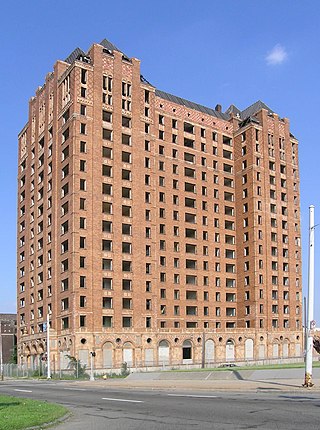
The Lee Plaza is a vacant 16-story high-rise apartment building located at 2240 West Grand Boulevard, about one mile west of New Center along West Grand Boulevard, an area in Detroit, Michigan. It is a registered historic site by the state of Michigan and was added to the United States National Register of Historic Places on November 5, 1981. Designed by Charles Noble and constructed in 1929, it rises to 16 floors and is an excellent example of Art Deco architecture of the 1920s.

The Belcrest Apartments is an apartment building located at 5440 Cass Avenue in Midtown Detroit, Michigan. It was built in 1926 as the Belcrest Hotel, designated a Michigan State Historic Site in 1983, and listed on the National Register of Historic Places in 1984. It is significant as an early example of the apartment hotel development concept in Detroit, and a major early work of architect Charles N. Agree.
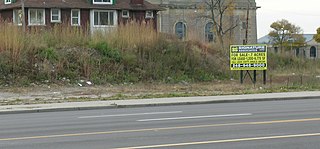
The Chateau Frontenac Apartments was an apartment building located in Detroit, Michigan. It bore the name of the famous Château Frontenac hotel. The building was listed on the National Register of Historic Places in 1991, but was subsequently demolished in 1999. It was removed from the National Register in 2020.
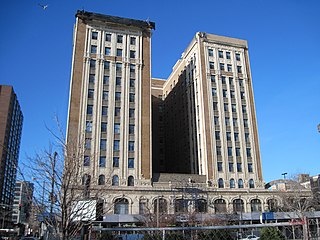
The Sheridan Plaza Hotel is a historic former hotel, now an apartment complex, located at the corner of Wilson Avenue and Sheridan Road in the Uptown neighborhood of Chicago, Illinois. The hotel was designed by Walter Ahlschlager.

The Ambassador is a historic apartment building located at Indianapolis, Indiana. It was built in 1924, and is a large six-story, tan cinder brick building. The first floor has Chicago school style commercial storefronts. It has a recessed entrance with detailed metal canopy and features Sullivanesque terra cotta ornamental detailing.

The Building at 257 East Delaware is a historic apartment building located at 257 East Delaware Place in the Near North Side neighborhood of Chicago, Illinois. The building was built in 1917 during a wave of luxury apartment construction on the Near North Side. Architect John Nyden designed the Renaissance Revival building, which was one of Chicago's first luxury apartments designed in the style. Like most skyscrapers of the area, the ten-story building is split into three parts visually; the upper two and lower two floors are faced with terra cotta and are connected by a brick shaft. The building is topped with a cornice and balustrade. Terra cotta lintels and decorations add an Adamesque influence to the building.

The Union Park Hotel is a historic hotel building located at 1519-1521 W. Warren Boulevard in Chicago, Illinois. The building was built in 1929-30 as an apartment hotel, a common type of housing for Chicago laborers in the 1920s. The hotel's Art Deco design reflects the national popularity of the style in the 1920s. The building's piers give it a vertical emphasis common to Art Deco works, and its decorative elements reflect the style's geometric focus. The colorful brick and terra cotta facade of the building is also characteristic of Art Deco buildings of the late 1920s, though color is seldom used extensively in Chicago's other Art Deco buildings.
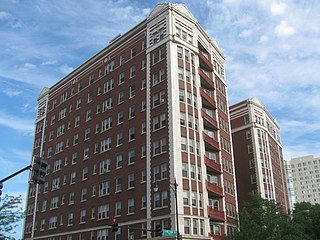
The East Park Towers are a historic apartment building at 5236-5252 S. Hyde Park Boulevard in the Hyde Park neighborhood of Chicago, Illinois. The building was constructed in 1922-23 during a period of residential growth in Hyde Park. While it had no guest rooms, the apartments offered similar amenities to an apartment hotel, such as housekeeping service. Apartment hotels were popular as part-time housing for wealthy workers, as they combined the amenities of in-home service with the affordability of apartments, and the East Park Towers were one of several such apartments built in Hyde Park at the time. Architect William P. Doerr designed the building in the Georgian Revival style; his design included terra cotta belt courses and quoins and Palladian windows on the first floor.

The Mayfair Apartments are a historic apartment hotel at 1650–1666 E. 56th Street in the Hyde Park neighborhood of Chicago. Built in 1926, the building was part of a wave of residential department in Hyde Park, and it was one of several apartment hotels constructed there in the late 1910s and 1920s. Apartment hotels were popular among wealthy workers looking for part-time city housing, as they combined the amenities and prestige of a hotel with the price and location of apartments. The architecture firm Lowenberg & Lowenberg designed the building in the Georgian Revival style. The building's first three stories are clad with limestone and decorated with flat Corinthian columns and balustrades on the second-story windows. The remainder of the building is brick and includes a dentillated cornice at its roof and a second cornice above its eleventh story.

The Poinsettia Apartments are an apartment hotel at 5528 S. Hyde Park Boulevard in the Hyde Park neighborhood of Chicago, Illinois. Built in 1929, the building was the last of several apartment hotels built in Hyde Park during a period of residential development in the late 1910s and 1920s. Apartment hotels were popular among wealthier workers in the city at the time, as they combined the amenities and prestige of hotels with the affordability of apartments. The Poinsettia Apartments were both the smallest of the Hyde Park apartment hotels and the only building designed in the Spanish Colonial Revival style. Its design features pilasters spanning the height of the building, terra cotta ornamentation, and decorative window surrounds on the first two floors.

The Belmonte Flats are two connected apartment buildings at the intersection of 43rd Street and King Drive in the Grand Boulevard community area of Chicago, Illinois. The older and taller of the two buildings was built in 1893, while the other building opened in 1896. The Grand Boulevard area was popular with affluent Chicagoans at the time, and apartments like the Belmonte Flats served as luxury apartment housing for these residents. Chicago architecture firm Patton & Fisher designed the apartments; both buildings have matching Chicago school designs with Queen Anne and Richardsonian Romanesque elements. The buildings both feature brick exteriors with limestone bases and terra cotta cornices, and the taller building has a turret at its corner. The interior features extensive detailing typical of luxury housing, including ornamental moldings and brackets and a mosaic tile floor in the lobby.

The Narragansett is a historic apartment building at 1640 E. 50th Street in the Kenwood neighborhood of Chicago, Illinois. The building was built in 1928 at the peak of apartment construction in Chicago, as apartments had grown in popularity throughout the early 20th century. It was one of several apartments built in the Chicago Beach Development, a lakefront property that was developed into a fashionable neighborhood known as Indian Village. Architects Leichenko and Esser designed the Art Deco building. The 22-story building features brick piers spanning its entire height, terra cotta spandrels dividing each floor, and decorative limestone on the first three floors.
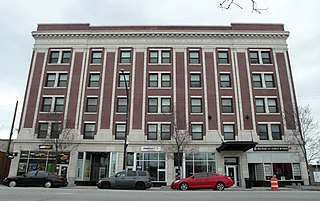
The Strand Hotel is a historic apartment hotel at 6315-6323 S. Cottage Grove Avenue in the Woodlawn neighborhood of Chicago, Illinois. Opened in 1915, the hotel offered both traditional guest rooms and long-term residences for customers who sought luxury amenities in apartment-style housing. Architects Davis & Davis designed the Classical Revival building, which has a red brick exterior with a terra cotta clad first floor, piers outlined in terra cotta, and an entablature and cornice at its roof. The hotel included a restaurant and banquet hall, the latter of which was used as a live music venue for many years. Once part of a major commercial district in Woodlawn, the hotel is now one of its few remnants and the only surviving apartment hotel building in the neighborhood.

The Yondorf Block and Hall is a historic building at 758 W. North Avenue in the Lincoln Park neighborhood of Chicago, Illinois. The building was built in 1887 to serve as a meeting hall for the various social organizations in Lincoln Park; while its first floor was dedicated to retail space, it had six meeting rooms on its upper floors. Chapters of national fraternal organizations and ethnic clubs formed by immigrants in the neighborhood met in the building, and its largest hall hosted speeches and performances as well. Designed by Frederick Alschlager, the building combines Victorian Gothic and Romanesque Revival elements. While its terra cotta clad storefronts and metal cornice are typical of the former style, its use of decorative brickwork and stone is inspired by the latter.

The Malden Towers are a historic apartment building at 4521 N. Malden Street in the Uptown neighborhood of Chicago, Illinois. The building was built in 1928–29, shortly before the Great Depression ended Chicago's prolific apartment construction of the early twentieth century. Architect N. T. Ronneberg designed the building in the style of a medieval Spanish castle. Ronneberg's design features a brick and terra cotta exterior with turrets at the front corners, arched first-floor windows, painted ornamental elements such as shields and fasces, and a parapet with battlements. The building thrived and attracted wealthy tenants despite the impending Depression, and in later years Bob Hope was rumored to be a resident.
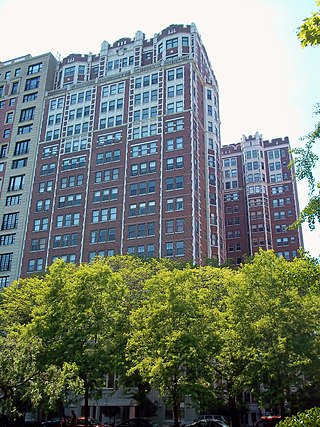
The Building at 2440 N. Lakeview Avenue is a historic apartment building in the Lincoln Park neighborhood of Chicago, Illinois. Built in 1926–27, the eighteen-story building was one of Chicago's many luxury apartment buildings constructed along Lake Michigan in the early twentieth century. The building used a semi-cooperative ownership model, in which the residents of the largest apartments had an ownership stake in the building while smaller units were rented; the cooperative model and its variations were popular with luxury apartments, as they gave residents control over how the building was run and who could live there. Architects Rissman & Hirschfeld designed the Tudor Revival building; while the Tudor Revival was one of many revival styles that became popular in the early twentieth century, it was relatively uncommon among Chicago's luxury apartments. The building's design features terra cotta arches around the entrances, ornamental terra cotta panels between the windows of the upper and lower floors, a balustrade atop the sixteenth floor, and a two-story penthouse with a broken parapet.

The Breslin is a historic six-story building in the Cliff/Cannon neighborhood of Spokane, Washington. It was designed by architect Albert Held in the Classical Revival style, and built in 1910 by W.H. Stanley with "Tenino sandstone, press red brick and cream-colored terra cotta" at a cost of $100,000.
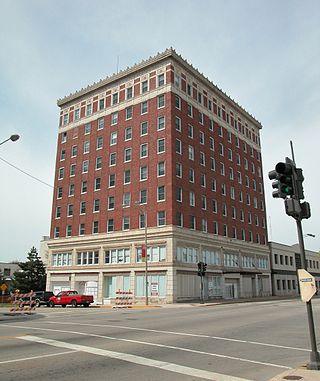
The Karcher Hotel is a historic hotel building at 405 Washington Street in Waukegan, Illinois. Opened in 1928, the hotel was built during an economic boom in Waukegan; its location near Waukegan's train station and downtown businesses was chosen to attract traveling businesspeople. In addition to renting rooms, the hotel housed commercial and office spaces on its first two floors. Architect B.K. Gibson of Chicago designed the hotel in the Classical Revival style; his design used the tripartite form common to Classical Revival skyscrapers, which included a two-story terra cotta base, a brick shaft, and an upper floor demarcated by terra cotta panels. Other classically inspired elements in the building include its terra cotta frieze, cornice, and parapet along with egg-and-dart and dentil detailing. While the hotel prospered during the Great Depression, it began to suffer economically in the 1960s and would ultimately close in 1981.























